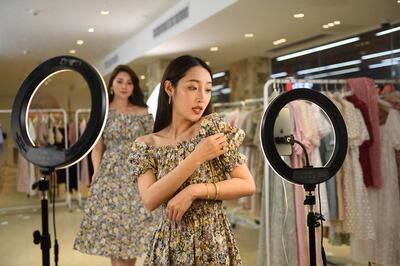
The Business of Fashion
Agenda-setting intelligence, analysis and advice for the global fashion community.

Agenda-setting intelligence, analysis and advice for the global fashion community.

While there is no denying that TikTok has become a social media juggernaut, “Douyin is much more advanced,” said Ada Luo, head of digital marketing agency Croud’s Asia-Pacific team.
For many in the West, Douyin is known — if at all — by virtue of it being the Chinese counterpart to TikTok, which despite becoming a flashpoint between China and geopolitical rivals like the US and India, has grown into a cultural phenomenon in the short span of five years. But according to some tech experts, Douyin is even more ambitious.
At a glance, Douyin’s app mirrors that of its sister platform. An advanced ‘for you’ algorithm tailors content to users’ interests, while influencers have options to post short videos and livestreams. But where Beijing-based owner Bytedance has made plans to expand TikTok’s e-commerce functionality in key markets like the US this year, Douyin has already built up an e-commerce infrastructure spanning in-app check-out, branded storefronts, livestream shopping and e-payments resulting in transactions that reached a gross merchandise volume of 500 billion yuan ($77.3 billion) last year.
Fashion and beauty brands have certainly taken note. From Adidas and Nike to luxury players Dior, Chanel and Louis Vuitton, major players have jumped on the Douyin bandwagon. On Lancôme’s page, a pinned post featuring heartthrob Kris Wu in a sunscreen ad has accumulated 159,000 likes; to celebrate Gucci’s re-show of its Aria collection in Shanghai, the brand posted 14 star-studded short videos in the lead-up to and on the day of the event.
ADVERTISEMENT
Douyin may not have TikTok’s international reach, but it is in the same league when it comes to audience size. Crucially, its users are highly engaged. “The experience of opening Douyin and soon realising an hour or two has passed… I know I’m not the only one,” wrote a Zhihu user, just one of many who have published stories attempting to root out what makes the app so addictive.
Douyin is pushing its own e-commerce function [so] the earlier you get in and build a foundation, the better.
While TikTok boasted around 689 million monthly active users worldwide as of January 2021, Douyin’s daily active users in China alone hit 600 million in August 2020. Douyin users spend around 100 minutes per day on the app, according to Luo, making it incredibly “sticky” and a major contender in the war for China’s screen time. Already, it has been hailed China’s “next WeChat.”
For brands selling to the Chinese mainland, launching on Douyin — and maintaining a consistent presence on the high-octane app — can be tricky. Not only does its algorithm favour chatty, down-to-earth posts seemingly at odds with premium brand storytelling, building engagement on the platform requires significant investment, in most cases without immediate returns.
How then should global players carve out their approach, especially in light of Douyin’s viral nature and latest functionality? Brands, retailers and experts weigh in.
What makes Douyin unique?
Like its international sister app, Douyin speaks to a younger and increasingly sought-after audience; Croud data reveals its biggest demographic is between 19 and 30 years old. But the app is also gaining in popularity among the older Chinese population.
Geographically, Douyin is especially popular across lower tier Chinese cities (Croud data pegs its penetration in tier three cities at 25 percent, compared to 6 percent in first tier hubs), which goes some way towards explaining its success. “Younger generations in lower tier cities have more spare time on their hands,” said Luo; she added that lower value products see faster returns on the app.
Like many competing apps in the social media and e-commerce space, Douyin is broadening its functionality beyond short videos in a bid to keep users tapped in.
ADVERTISEMENT

The app has started trialling “life services” in some Chinese cities to rival the likes of Meituan, where users can make restaurant reservations and cinema tickets. “It’s increasingly becoming the same kind of Swiss Army Knife that WeChat has been for a few years, and is therefore acquiring a lot of users,” said Adam Knight, co-founder of Tong Digital, which counts Anya Hindmarch, Charlotte Tilbury and Estée Lauder among its clients.
Having evolved from its short video origins, the platform is now driving a third wave of Chinese e-commerce, which began with marketplaces like Tmall and JD in the 90s and early noughties, followed by second-wave social e-commerce players like Pinduoduo and WeChat. The app launched flagship stores in March; brands like Adidas as well as local fashion giants Peacebird and Semir have already set up their own boutiques on the app.
Though exciting, the commercialisation of platforms like Douyin can be quite daunting and challenging for brands — the more content-centric commerce has become, the bigger the investment companies need to establish their online presence, Knight added.
Despite all its new bells and whistles, Douyin is, at its core, a way for brands to get their products in front of new audiences, with food and drink, beauty and daily necessities being its best performing categories. “Because the algorithm leans towards discovery the platform invests a lot into livestream e-commerce, people are tuning into different livestream events in order to find cheap deals, new brands and understand more about the product,” said Luo.
Which brands should be using it?
The app’s younger audience and high penetration in lower tier Chinese cities generally makes it a good fit for fast fashion players and more affordable brands. “You must invest in it, particularly as Douyin is pushing its own e-commerce function... the earlier you get in and build a foundation, the better,” said Luo.
Douyin is pushing its own e-commerce function [so] the earlier you get in and build a foundation, the better.
For businesses peddling higher-end fashion or beauty, Douyin can be a mixed bag. Luo cited figures revealing that 49 percent of top luxury brands have set up accounts on Douyin, the lowest among China’s top platforms, which include WeChat, Weibo and Xiaohongshu. “Few [brands] do well,” she added, noting the difficulty some high-end players have in translating their premium positioning to an interface that favours entertaining, fast-paced content. Knight recalled that when Gucci first launched on the platform, it received criticism from netizens saying its content and high-end positioning were mismatched. “People thought it looked low-end,” he said.
Because of its younger audience and discovery-centric interface, luxury brands in particular need to see Douyin as an engagement-boosting branding tool, rather than a sure-fire way to move product. Premium players looking for a speedy return on investment are on the wrong platform, warn experts. “The purchase journey is longer and the user is still trying to learn about what your brand is [so] they won’t immediately want to buy a bag or piece of clothing,” said Luo.
ADVERTISEMENT

But Douyin remains a crucial touchpoint for luxury players looking to grow brand awareness among China’s Gen-Z; the demographic may not make a purchase immediately upon spotting it on the platform, but building recognition can pay off in the long-run once those users have more disposable income at their fingertips.
Whatever their price point, brands need to commit to investing in Douyin at the outset, from producing content especially for the platform to hiring and training staff to become experts. “The worst [scenario] is if brands do go in but don’t invest enough and do it halfway,” said Luo. “You’re not going to see results. It’s a long-term investment.”
In terms of manpower, Knight typically sees two people on the brand side oversee Douyin output. But the human resources brands need to realise their Douyin goals can vary; managing a flagship store and creating livestreams, for example, can necessitate bringing more hands on deck.
How to get the most out of it?
Setting up an official account may seem like the obvious first step, but brands looking to enter Douyin have several options. “To be successful on Douyin, you don’t need to have a brand-owned account,” said Knight. Advertising can be a great option for fashion and beauty companies testing the Douyin waters — especially those lacking resources to consistently produce their own high-quality dedicated content. The platform’s advertising offering is advanced and extremely targeted, thanks to Douyin’s machine learning chops.
Knight notes that this is particularly effective for Chinese users based outside the mainland, with returns on investment in ads beating the likes of more mature apps like Weibo, Xiaohongshu and WeChat. “There aren’t that many brands advertising on [Douyin] outside China, so from a cost-per-engagement standpoint it’s a very competitive place to put your money.” L’Oréal and Dior Beauty are among the brands currently tapping into Douyin’s ad reach.

Key opinion leaders, or KOLs, are another option, but not the be-all-end-all. Influencer content can often be higher quality, if not more entertaining and effective, on the app, but brands on a tight budget will find long-term KOL activations unaffordable. The key is to ensure every KOL link-up is creative and on-brand, and invest in a follow-through strategy so that the brand doesn’t drop off the map once their campaign ends.
“You are, for all intents and purposes, borrowing audiences,” said Knight. “You’re not building your own audience but renting somebody else’s and hoping to convert some of them to your [owned channels].”
For brands with e-commerce set up on platforms like WeChat, Douyin began blocking links to the super app this year in an escalation of the ongoing competition between Bytedance and WeChat owner Tencent. Linking to stores on JD and Tmall are still possible, but brands will have to dole out more in commission, compared to linking to a Douyin flagship store, which is said to take a 3-5 percent cut. Luo recommends brands set up shop on the app directly if they have the resources to do so. “It’s going to become the norm,” she said.
Chinese regulators are attempting to stop this fragmentation between digital “walled gardens” through anti-competition laws, but “for now it’s still hard to track users from one platform to another; unless you build everything within Douyin, it’s hard to understand how what you’re doing on Douyin can lead to sales elsewhere,” said Knight.
How to map out the right strategy:
Brands need to keep an eye on their data. Like many Chinese platforms, data fraud on Douyin is an open secret. “It’s everywhere to be honest, but particularly for KOL [traffic], livestreams, fake orders, fake followers,” said Luo. She recommends brands do due diligence on their prospective partners with third-party data to ensure they are making smart investments.
On its own, Douyin data can help brands better target users on the platform, but it becomes more valuable if they map out customer IDs across platforms. “Unless you’re really investing in connecting the dots and seeing how Douyin fits into your broader channel strategy… it’s not necessarily going to be the most useful information.” As with all digital platforms, brands can also work with agencies and other third parties to make the most of their data.
Finding an authentic voice, and sticking to it, pays off. Brands will understandably want to test out different approaches at first, but once they settle on a storytelling style, consistency is key. “If you post two times and livestream once a week, stick to it; don’t post something funny and then something serious the next day,” said Luo.
Take Net-a-Porter, which uses its Douyin account to target young professionals with practical but fun posts. A recent video advises viewers on how to style the same bag for the office, off-duty hours and on holiday; another series, led by actor Vin Zhang, gives its audience summer style advice in the format of a tongue-in-cheek airline safety video. Fellow luxury e-tailer Farfetch takes a different, more casual approach, with a series that teaches viewers how to pronounce brand names like Isabel Marant and briefly recaps each brand’s USP. One post introducing eyewear brand Gentle Monster, cleverly using celebrity Kris Wu as its thumbnail, garnered 34,000 views.
Brainstorm creative concepts with the app in mind. “Brands need to figure out how Douyin fits into [their wider strategy,] not just treat it as an extension of the content they’re already producing,” said Knight. This means creating content for the app and its audience, rather than recycling a campaign from Xiaohongshu or WeChat. Posts needs to be vertical, attention-grabbing and faster-paced than other apps because people scroll down the Douyin feed faster, said Luo. “You can [recycle creatively], but you need to accept that click-throughs and engagements will be lower.”
Luo raised Gucci as an example of a brand that has warmed up to Douyin’s unique demands; a recent post advertising the brand’s Shanghai exhibition featuring the likes of actor Lu Han in a highly stylised retro game-show format clocked 33,000 likes. “It’s fun, it’s entertaining, it features effects and celebrities people like, which guarantees engagement,” Luo said.
However, celebrities aren’t necessary to a Douyin post’s success: a recent video by C-beauty giant Perfect Diary spotlights the long process the brand went through to improve its loose powder, including testing it on 200 people and 100 versions of their formula, before landing on the final product. In the comments, fans of the brand voiced their appreciation for the brand’s efforts. “I want to be in the next round of tests,” one user wrote.
Related Articles:
With consumers tightening their belts in China, the battle between global fast fashion brands and local high street giants has intensified.
Investors are bracing for a steep slowdown in luxury sales when luxury companies report their first quarter results, reflecting lacklustre Chinese demand.
The French beauty giant’s two latest deals are part of a wider M&A push by global players to capture a larger slice of the China market, targeting buzzy high-end brands that offer products with distinctive Chinese elements.
Post-Covid spend by US tourists in Europe has surged past 2019 levels. Chinese travellers, by contrast, have largely favoured domestic and regional destinations like Hong Kong, Singapore and Japan.